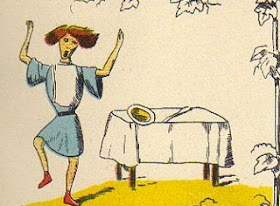This post has appeared before, as have my recent posts on How to Make Stock. I’ve brought them back because this is a difficult time. Just as we’re all in this together, we all need to pull together and support one another as COVID-19 knocks on the door.
Making stock is both comforting and practical. So’s freezing that stock, making what we have last, and wasting nothing. Ron and I have begun growing lettuce and herbs - something that can be done in a small space, providing a measure of satisfaction. We’ve just harvested the crop of garlic we planted last October. We’ve planted squash between the flowers, as we did last year. It’s good to have something to look forward to, and we’re looking forward to this.
Although this “How to” series likely features things you know, not everyone does. My tried-and-true method for How to Freeze Food may be “different” from yours. It may also give you a much-needed laugh. Hang on, Dollinks ... hang on.
I am a highly organized woman. I balance my check book to the penny, file every receipt, keep warranties, and generally have my life in order - the exception being the archeological dig that is our freezer. I’m reasonably well-stocked in the freezer department - the only minor crisis being an occasional imbalance in bits and bobs (too many bits - too few bobs).
As I recently clawed my way through the ice to find last summer’s bacon fat, my thoughts turned to freezers. I wanted that bacon fat. I needed it. Nothing works better in my favorite recipe for Red Cabbage. To save space, I’d stashed the fat in a thimble-sized plastic container, as any highly organized woman would do.
I excavated the levels of frozen food past Woodstock, past the Great Depression, past the Ming Dynasty… No bacon fat. Slowly coming to grips with the realization that it was gone, I speculated that it may have migrated to that mysterious place that houses single socks, or maybe into the hands of someone who wanted it even more than I did. Prime suspect? Ron. Clues? Freshly greased hair. Bacon-scented cologne. Paper-thin alibi.
That got me thinking about a system that would never fail (unless the item in question were bacon fat - which, as everyone knows, is highly prized as an ingredient in foods such as, um … bacon).
Forget the system we used in the ’80s. It was too obsessive ... too compulsive … too what-e-ver.
Here’s how it worked back then: Let’s say you froze eight pork chops and six T-bones (I used to be more extravagant, actually buying T-bones. It was just T-bones, of course. I couldn’t afford the steak draped over them). So let’s return to our eight pork chops and six T-bones.
Taped to the outside of the freezer was a little sign: “Pork chops,” it read. “T-bones.” And so forth. Beside the notation for “Pork chops” was / / / / / / / / Next to “T-bones,” I wrote: / / / / / /
Whenever something left the freezer, I stroked through the item count, changing it to an X. The system failed because our kids removed stuff willy-nilly. It was crazy-making. So now I just dig, using the same technique employed in the frantic search for victims flattened by fallen buildings.
Full disclosure? I’ve stopped putting pork in the freezer. We’ve been unable to stomach it since the time I bought a 23-lb. (10 kg) pork leg on sale at a buck a pound (Miss Piggy Goes to Market). We briefly considered converting to another religion to avoid pork, but our love of bacon and shellfish was overwhelming.
(Digression: I’m still traumatized by an unfortunate experience I had in the ’90s. I left town for a single day, only to return to see my then-husband glazed in sweat. He’d scraped through layers of ice to retrieve and chuck the bags of pumpkin I’d been saving since the ’70s for future use in soups and scones. Is it any wonder we divorced?)
My new system will be foolproof. It will be easy. It will organize your freezer and mine for once and forever (though finding the missing bobs is probably hopeless). Here goes:
(1) Peer into your sorry excuse of a freezer. You’re probably thinking “No room, no room!” Remember the Mad Hatter’s tea party? Using my system, you’ll soon have plenty of room.
(2) Buy stackable rigid containers in various sizes. Use freezer-grade plastic bags for meat and seafood.
(3) Transfer chilled food to containers. Wash previously used containers with soap and hot water: No cross-contamination in your kitchen!
(4) Using indelible ink or label maker, mark filled packages by content, quantity, current date, and expiry date.
(5) For efficient date-rotation, store containers in bottom of freezer.
(6) For reasons unknown, containers never migrate to top of freezer.
(7) Toss.
















